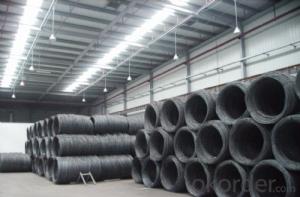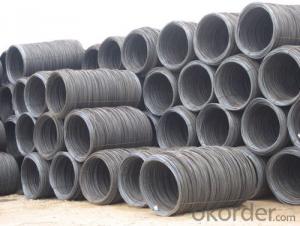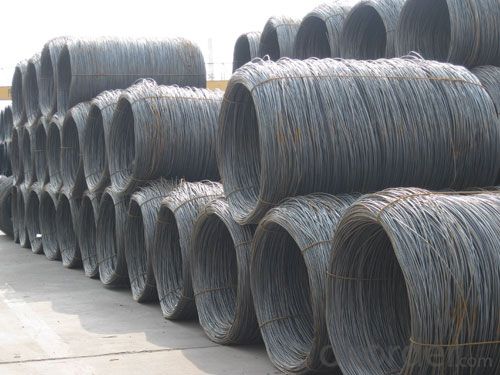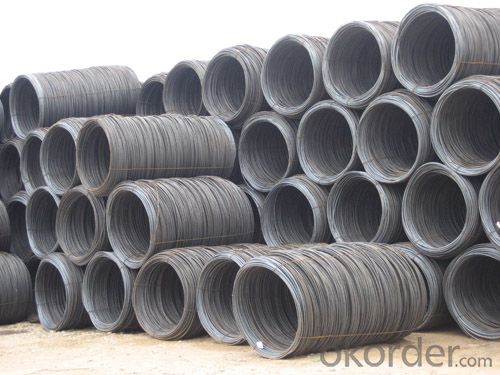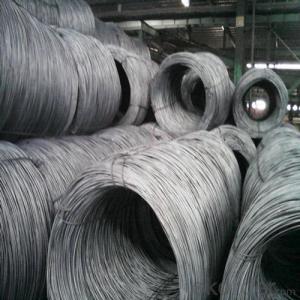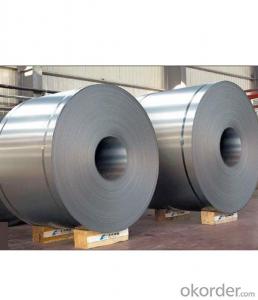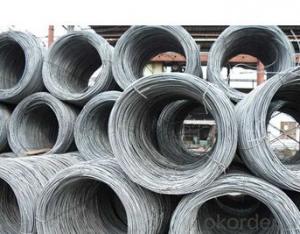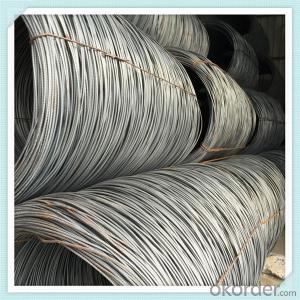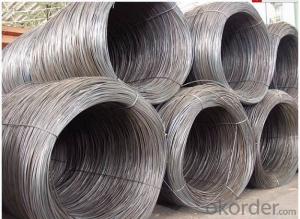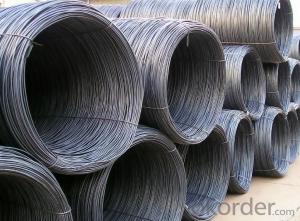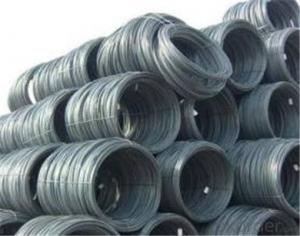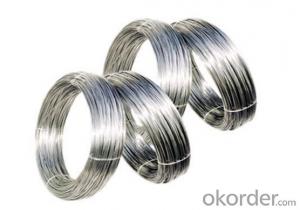SAE1008 Steel Wire Rod with High Quality 5.5mm-12mm
- Loading Port:
- China Main Port
- Payment Terms:
- TT or LC
- Min Order Qty:
- 40 m.t
- Supply Capability:
- 15000 m.t/month
OKorder Service Pledge
OKorder Financial Service
You Might Also Like
Production Description:
Specifications of Wire Rod SAE1008B:
Grade: SAE1008B Standard: ASTM
Diameter: 5.5mm, 6.5mm, 7mm, 8mm, 9mm, 10mm, 11mm, 12mm
Alloy or Not: Alloy
Technique: Hot Rolled Place of Origin: China Mainland
Chemical Composition:
Please kindly find our chemistry of our material based on SAE1008B as below for your reference:
Grade | Chemical Composition (%) | |||||
C | Mn | S | P | Si | B | |
SAE1008B | 0.10max | 0.30-0.50 | 0.050max | 0.040max | 0.30max | 0.0008min |
Mechanical properties | ||||||
Yield strength(N/mm2) | Tensile strength(N/mm2) | Elongation (%) | ||||
≥195 | 350-380 | ≥32 | ||||
Usage and Applications of SAE1008 Steel Wire Rod with High Quality 5.5mm-12mm:
After hot-rolled the products shaped into coil and delivery as finished product, including round, square,rectangular, hexagonal and so on. Since most of the products are round, it is generally called wire rod. Carbon steel wire rod is widely used in construction and manufacturing. Carbon steel wire rod is mainly used for reinforcement of reinforced concrete and welded structure or reprocessed (roberts , nail, etc.) materials, especially used to produce wire drawing, welding electrode, nails, spring, electronic, precise machinery parts and so on.
Packaging & Delivery of SAE1008 Steel Wire Rod with High Quality 5.5mm-12mm:
Packaging Detail: products are packed in coil and then shipped by container or bulk vessel
Each coil weight: About 2.05MT
Delivery Detail: within 45 days after received deposit or LC.
Label: to be specified by customer, generally, each bundle has 1-2 labels
Trade terms: FOB, CFR, CIF
FAQ:
Q1: How soon can we receive the product after purchasement?
A1: Within three days of placing an order, we will begin production. The specific shipping date is dependent upon international and government factors, but is typically one month.
Q2: How do you guarantee the quality of our products?
A2: We have established an advanced quality management system which conducts strict quality tests at every step, from raw materials to the final product. At the same time, we provide extensive follow-up service assurances as required.
Q3: The prices are invoicing on theoritical weight or on actual weight?
A3: We can do it in both manners, according to the customers' request.
Images of SAE1008 Steel Wire Rod with High Quality 5.5mm-12mm:
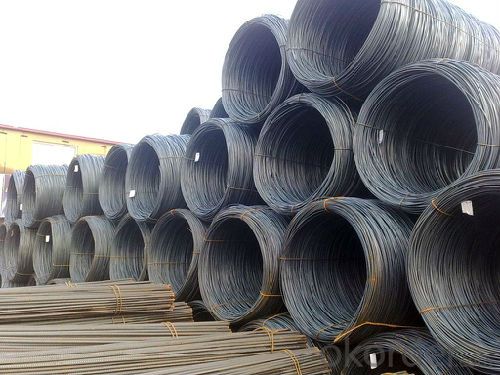
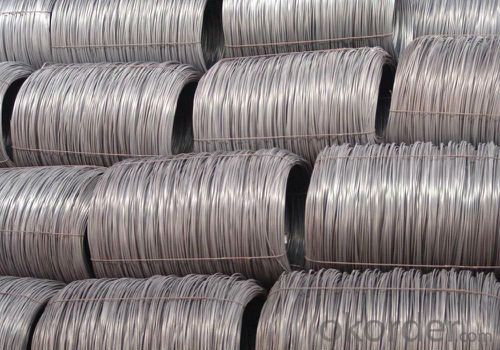
*If you would like to get our price, please kindly inform us the size, standard/material and quantity. Thank you very much for your attention.
- Q: How are steel wire rods used in the manufacturing of springs?
- Steel wire rods are an integral component in the manufacturing of springs. These rods, which are typically made from high-quality steel, are first subjected to various processes such as hot rolling, cold drawing, and heat treatment to enhance their strength and durability. Once the steel wire rods have been prepared, they are then further processed to create the desired shape and characteristics for different types of springs. This can be achieved through techniques like coiling, twisting, or bending the wire rods into specific forms. The steel wire rods serve as the primary material for springs due to their excellent mechanical properties, such as high tensile strength and flexibility. These qualities are crucial for springs as they need to resist deformation and provide the necessary force when compressed or stretched. Furthermore, the steel wire rods used in spring manufacturing undergo stringent quality control measures to ensure consistency and reliability in their performance. This involves conducting tests to evaluate the wire's mechanical properties, such as tensile strength, elasticity, and fatigue resistance. Overall, steel wire rods play a vital role in the manufacturing of springs by providing the necessary strength and versatility required for these essential components. Their ability to withstand various forces and maintain their shape over time makes them a reliable choice for a wide range of applications, including automotive, aerospace, and industrial sectors.
- Q: What are the safety considerations when working with steel wire rod?
- When working with steel wire rod, there are several safety considerations to keep in mind. Firstly, it is important to use personal protective equipment such as gloves, safety glasses, and steel-toed boots to protect yourself from potential injuries. Additionally, it is crucial to ensure that the work area is clean and free from any obstructions that may cause tripping or falling hazards. Proper training and knowledge of handling equipment, such as cranes or forklifts, is essential to prevent accidents. Finally, regular inspections and maintenance of the wire rod and related machinery should be conducted to identify any potential hazards and prevent them from causing harm.
- Q: How is steel wire rod used in the manufacturing of piano wire?
- The production of piano wire involves several manufacturing steps using steel wire rod. To begin with, the rod undergoes cleaning and descaling to eliminate impurities and surface contaminants. Subsequently, it is heated to a specific temperature to enhance its malleability and workability. Following this, the steel wire rod is gradually reduced in diameter by being drawn through a series of dies. This process, called wire drawing, involves pulling the rod through a die with a smaller hole size. As a result, the rod becomes elongated and thinner, while its strength and tensile properties increase. This drawing process is repeated until the desired wire thickness is achieved. Once the desired thickness is attained, the wire undergoes further heat treatment to improve its mechanical properties. This heat treatment process, known as patenting, includes heating the wire to a specific temperature and then rapidly cooling it. This enhances the wire's strength, elasticity, and resistance to deformation. After the patenting process, the wire is meticulously inspected for any defects or imperfections. Any flawed wire is discarded to ensure that the final product adheres to the highest quality standards. The resulting steel wire, now in the form of piano wire, possesses exceptional tensile strength, enabling it to endure the high tension necessary for piano strings. Its inherent flexibility allows it to vibrate freely, producing the rich and resonant tones associated with high-quality pianos. In conclusion, steel wire rod plays a crucial role in piano wire manufacturing due to its strength, durability, and flexibility. Through processes such as cleaning, heating, wire drawing, and heat treatment, the wire rod is transformed into a high-tensile steel wire capable of meeting the demanding requirements of piano strings.
- Q: How is steel wire rod used in the production of tire reinforcement materials for motorcycles?
- Steel wire rod is commonly used in the production of tire reinforcement materials for motorcycles. It is primarily used as the main component in steel cords, which are embedded in the tire rubber to enhance its strength and durability. These steel cords provide excellent resistance against punctures, enhance the tire's structural integrity, and improve overall performance. Additionally, steel wire rod is also used in the production of bead wires, which help to secure the tire to the rim. Overall, steel wire rod plays a crucial role in ensuring the safety and reliability of motorcycle tires.
- Q: How does the hardness of steel wire rod vary with different wire drawing processes?
- The hardness of steel wire rod can differ depending on the wire drawing processes employed, owing to several factors. To begin with, the hardness of the steel wire rod is influenced by the reduction in diameter that occurs during the wire drawing process. As the wire is pulled through a series of dies, the material undergoes plastic deformation. This deformation causes the grains within the steel to elongate and align in the direction of the wire, resulting in increased hardness. The extent to which the diameter is reduced directly impacts the amount of deformation and, consequently, the hardness of the wire rod. Moreover, the speed at which the wire is drawn plays a role in determining its hardness. Higher drawing speeds tend to impose more strain on the material, leading to greater deformation and higher hardness. Conversely, slower drawing speeds may result in less deformation and lower hardness. Furthermore, the heat generated during the wire drawing process can affect the hardness of the steel wire rod. Friction between the wire and the dies generates heat, which can cause the material to soften. If the wire is not adequately cooled during the drawing process, its hardness may decrease. Conversely, controlled cooling techniques can be utilized to maintain or enhance the hardness of the wire rod. Lastly, the lubrication chosen for the wire drawing process can impact the hardness of the steel wire rod. Appropriate lubrication reduces the friction between the wire and the dies, minimizing heat generation and preventing surface damage. This allows for more controlled deformation, resulting in the desired level of hardness. In conclusion, the hardness of steel wire rod varies depending on the wire drawing processes employed, due to factors such as the extent of diameter reduction, drawing speed, heat generation, and lubrication. These factors must be carefully considered and controlled to achieve the desired hardness in the final wire product.
- Q: What are the different types of steel wire rod coatings used for increased corrosion resistance?
- To enhance corrosion resistance, there exist several commonly used coatings for steel wire rods. These coatings are applied to the wire rod's surface to safeguard it against environmental elements that can cause corrosion. Some of the coatings employed for increased corrosion resistance comprise: 1. Zinc Coating: Zinc coatings, like hot-dip galvanizing, find extensive usage in providing corrosion resistance to steel wire rods. The zinc coating acts as a shield between the steel and the surrounding environment, thereby preventing the oxidation of the underlying metal. 2. Aluminum Coating: Steel wire rods frequently benefit from aluminum coatings for heightened corrosion resistance. These coatings generate a protective oxide layer on the wire's surface, thus obstructing the formation of rust and other forms of corrosion. 3. Polymer Coating: Polymer coatings, such as epoxy or polyurethane, are applied to steel wire rods as a protective barrier against corrosion. These coatings are renowned for their exceptional resistance to moisture, chemicals, and abrasion, rendering them suitable for applications involving exposure to harsh environments. 4. Phosphate Coating: Phosphate coatings are often utilized as a pretreatment before applying other protective coatings. These coatings enhance the adhesion of subsequent coatings while providing supplementary corrosion resistance. 5. Chromate Conversion Coating: Steel wire rods can be treated with chromate conversion coatings to bolster their corrosion resistance. These coatings form a thin layer of chromium oxide on the wire's surface, acting as a barrier against corrosion. It is crucial to consider various factors, including the specific application, environmental conditions, and desired level of corrosion resistance, when selecting the appropriate coating.
- Q: What are the safety requirements for steel wire rod used in elevator wire ropes?
- The safety requirements for steel wire rod used in elevator wire ropes include factors such as the wire's tensile strength, flexibility, fatigue resistance, and corrosion resistance. It should meet industry standards and be able to withstand the weight and stress placed on it during elevator operation. Additionally, the wire rod should be properly tested and certified for its quality and performance to ensure the safety of elevator passengers and operators.
- Q: What are the different hardness testing methods for steel wire rod?
- There are several hardness testing methods for steel wire rods, including the Rockwell hardness test, Brinell hardness test, Vickers hardness test, and Knoop hardness test. Each method involves applying a specific amount of force or pressure to the surface of the wire rod and measuring the depth or size of the indentation left by the indenter. These tests help determine the hardness and strength of the steel wire rod, providing valuable information for quality control and material selection purposes.
- Q: How is steel wire rod used in the manufacturing of wire ties for construction sites?
- Steel wire rod is an essential component in the manufacturing of wire ties for construction sites. These wire ties are widely used in the construction industry for various purposes, such as securing rebar, reinforcing concrete structures, and fastening construction materials together. The steel wire rod serves as the raw material for producing wire ties. It undergoes a series of processes to transform it into the final product. First, the wire rod is cleaned and coated to enhance its corrosion resistance. This coating, often made of zinc, provides an added layer of protection against rust and ensures the wire tie's longevity in harsh construction environments. Next, the coated steel wire rod is fed into a wire drawing machine where it is pulled through a die to reduce its diameter to the desired size. This process is repeated several times to achieve the required wire thickness and strength. Once the wire is drawn to the desired gauge, it is then cut into appropriate lengths to produce individual wire ties. These lengths can vary depending on the specific application and requirements of the construction project. The wire is then bent, twisted, or formed into the shape of a tie using specialized machinery. Wire ties made from steel wire rod offer exceptional strength, durability, and flexibility. They can be easily bent or twisted to fit around various construction materials, ensuring a secure and tight connection. Moreover, the high tensile strength of steel wire rod ensures that the wire ties can withstand considerable stress and load without breaking or deforming. The wire ties manufactured from steel wire rod are commonly used in construction sites to secure and fasten rebar during concrete pouring. They are also used to reinforce concrete structures, such as walls, columns, and beams. Additionally, wire ties are employed to bundle or tie together construction materials, including pipes, cables, and electrical wires, ensuring proper organization and preventing potential hazards. In summary, steel wire rod plays a crucial role in the manufacturing of wire ties for construction sites. These wire ties provide essential support and reinforcement in various construction applications, offering durability, flexibility, and strength to ensure the safety and stability of construction projects.
- Q: How is steel wire rod stored at the customer's site?
- Depending on specific requirements and conditions, customers typically store steel wire rod in various ways on their site. One commonly used method is to place the rods on racks or pallets, particularly if there is a large quantity involved. These racks or pallets are usually arranged in an organized manner to ensure easy access and safety. In addition to racks or pallets, smaller quantities or wire rods that need to maintain their shape and integrity can be stored in bundles or coils. To prevent any movement or damage during storage or transportation, these bundles or coils are often secured with straps or bands. To prevent corrosion or damage, it is crucial to have a dry, clean, and well-ventilated storage area for steel wire rod. Additional protection measures, such as covering the wire rod with tarps or plastic sheets, may be used to shield it from dust, moisture, or other environmental elements. Customers should carefully follow any specific storage instructions provided by the manufacturer or supplier to ensure the long-lasting quality of the steel wire rod. These instructions may include guidelines on temperature control, stacking limitations, or the use of specialized equipment for handling and storage. Ultimately, the storage of steel wire rod at the customer's site should prioritize safety, accessibility, and protection to guarantee optimal performance and usability of the product.
Send your message to us
SAE1008 Steel Wire Rod with High Quality 5.5mm-12mm
- Loading Port:
- China Main Port
- Payment Terms:
- TT or LC
- Min Order Qty:
- 40 m.t
- Supply Capability:
- 15000 m.t/month
OKorder Service Pledge
OKorder Financial Service
Similar products
Hot products
Hot Searches
Related keywords

